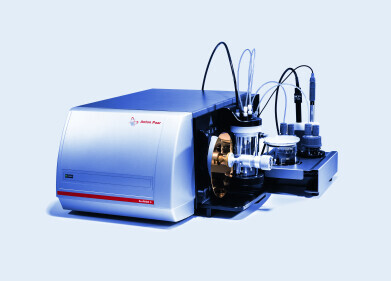-
---Pearl-Oyster-Cell.jpg)
-
.jpg)
-
.jpg) Figure 1: A comparison of new & used Castrol Magnatecs.
Figure 1: A comparison of new & used Castrol Magnatecs. -
.jpg) Figure 2: Example spectrum showing the fringing pattern for a parallel windowed cell. Using the calculation shown above this cell was determined to have a pathlength of 108.5 µm.
Figure 2: Example spectrum showing the fringing pattern for a parallel windowed cell. Using the calculation shown above this cell was determined to have a pathlength of 108.5 µm.
Laboratory Products
How to Accurately Analyse Viscous Substances Using IR Spectroscopy
Jan 24 2020
Infrared spectroscopy of some liquids is best accomplished in transmission mode, where the whole sample is exposed to the path of the infrared beam. The advantages over ATR include higher sensitivity and accurate determination of pathlength – essential for accurate quantitation.
Traditional liquid transmission cells are simple in construction, consisting of no more than two IR transmitting windows and a thin spacer clamped together with backing plates. Although simple by design, their use can be complicated by viscous samples which may stick or apply unevenly to the windows.
These same samples are also difficult to introduce and clean from a cell, requiring careful reassembly after each sample. This makes accurate and repeatable control of the pathlength near impossible.
The Pearl™ liquid transmission accessory holds the innovative horizontally mounted Oyster™ cell, consisting of two precision machined window holders which match to provide a highly repeatable pathlength without the use of spacers.
New and used motor oils
Service oils are designed to minimise wear-and-tear in engines. Over time the oils pick up elemental metals, soot and other contaminants which visibly spoils the oil. ATR analysis is typically not sensitive enough to pick out the early signs of this degradation, requiring the larger effective pathlength of a transmission measurement to determine.
IR spectral analysis can help determine which contaminants are present, as well as what kind of chemical degradation has occurred in the oil. Traditionally, a vertically mounted cell was the go-to method for loading viscous or sticky fluids. However, this approach leads to problems with sample loading, consistent pathlengths, and cell clean-up.
Figure 1 compares the spectra of fresh and used Castrol Magnatec oil samples using a 25 µm pathlength. Very little sample (< 5 ml), was needed to quickly differentiate the oils. The used sample shows clear evidence that the oil has been chemically altered and presence of contaminants.
Evidence of sulfation is observed by the growth of bands around 1150 cm-1, while the 1600 – 1700 cm-1 region shows evidence of oxidation and nitration in the oil. There is a loss of relative signal intensity at ca. 1500 and 1460 cm-1. This is marked by blue circles and indicates a decreased concentration of the original oil in the used sample.
Evaluation of aged transformer oils
Mineral oils are employed as thermal and electrical insulators in many power transformers. Thermal and electrical stress over the lifetime of the transformer results in the chemical breakdown of the oil, which can be monitored using FTIR spectroscopy and principal component analysis (PCA).
These chemical changes are accompanied by changes in physical properties such as viscosity, making consistent and reliable sampling of the oils a challenge. In particular, achieving a consistent pathlength for FTIR analysis becomes challenging. Here the Pearl™ liquid transmission accessory, fitted with an oyster cell™, is advantageous as a consistent pathlength can be easily achieved even for the most viscous of oil samples.
Determining pathlength for standard measurements
In many industries it is common to carry out measurements according to standards published by bodies such as the American Society for Testing and Materials (ASTM) or the German Institute for Standardization (DIN).
A basic requirement of such methods is to determine the pathlength of a transmission cell independently of any nominal pathlength established by the manufacturer.
The Oyster™ cells come in two configurations, one with a parallel window arrangement and another with ‘wedged’ windows, where a very small angle is allowed between the planes of the two windows. Doing so prevents the appearance of so-called ‘fringing’ (or etalon) effects in the spectra recorded with the cell which result from multiple reflections between two parallel windows.
Since the periodicity of the fringing is related to the distance between the two windows, this is the principal method of accurately determining the pathlength of a transmission cell.
From the fringing pattern obtained in an empty cell, the pathlength of the cell can be calculated from the following formula:
P = 5000 n / (ν1 – ν2)
Where: P = pathlength in micrometers
n = number of fringes
ν1 = wavenumber at first peak (in cm-1)
ν2 = wavenumber at second peak (in cm-1)
Specac have recently developed a simple software tool for determining the pathlength of Oyster™ cells directly. This is now available for download on the Specac website and is free to use. The software determines the pathlength of parallel cells using the fringing calculation, whilst wedged cells are determined from the absorbance of a standard solvent, n-heptane.
Digital Edition
Lab Asia 31.2 April 2024
April 2024
In This Edition Chromatography Articles - Approaches to troubleshooting an SPE method for the analysis of oligonucleotides (pt i) - High-precision liquid flow processes demand full fluidic c...
View all digital editions
Events
Apr 25 2024 Istanbul, Turkey
Apr 28 2024 Montreal, Quebec, Canada
May 05 2024 Seville, Spain
InformEx Zone at CPhl North America
May 07 2024 Pennsylvania, PA, USA
May 14 2024 Oklahoma City, OK, USA
.jpg)
















